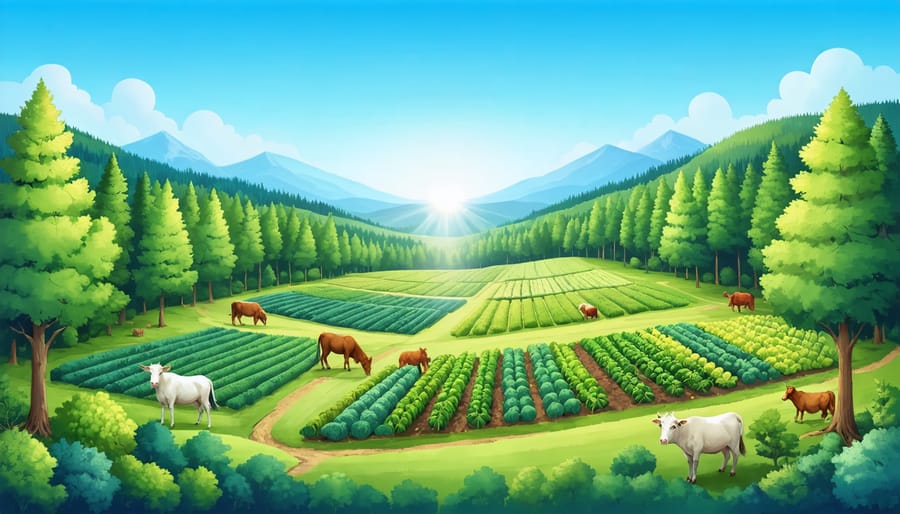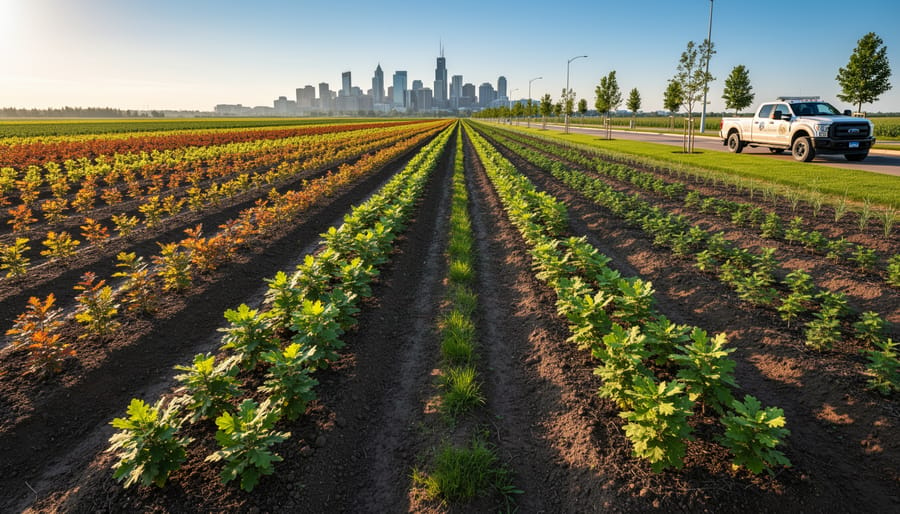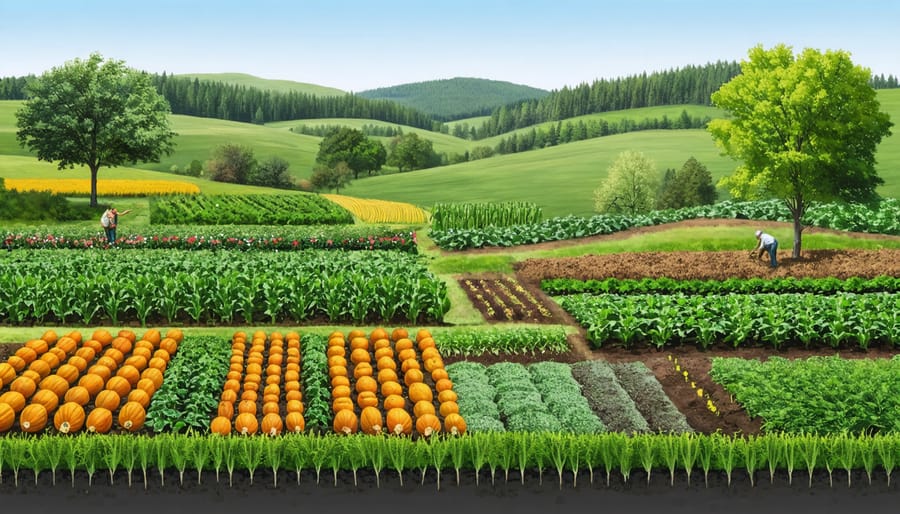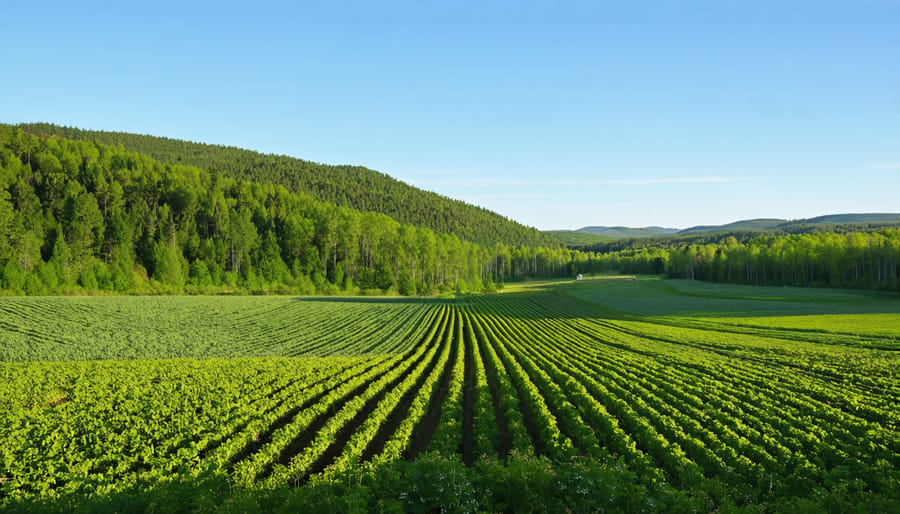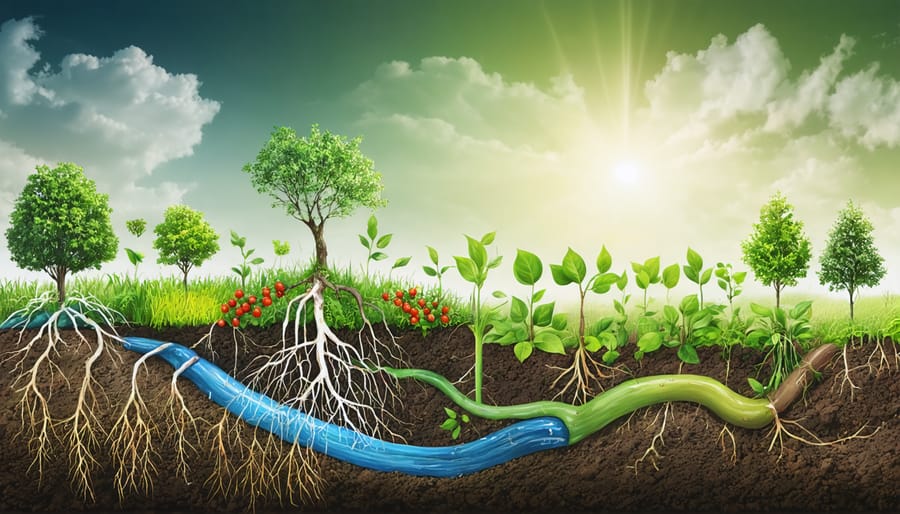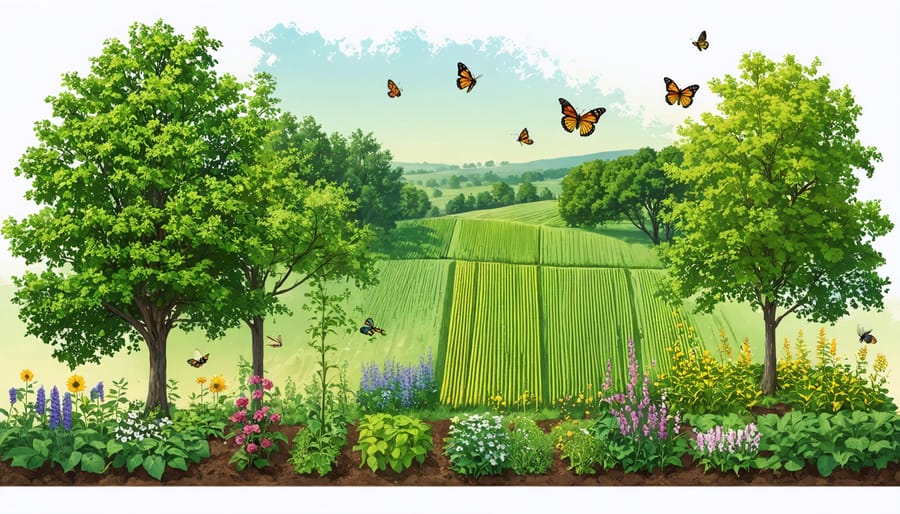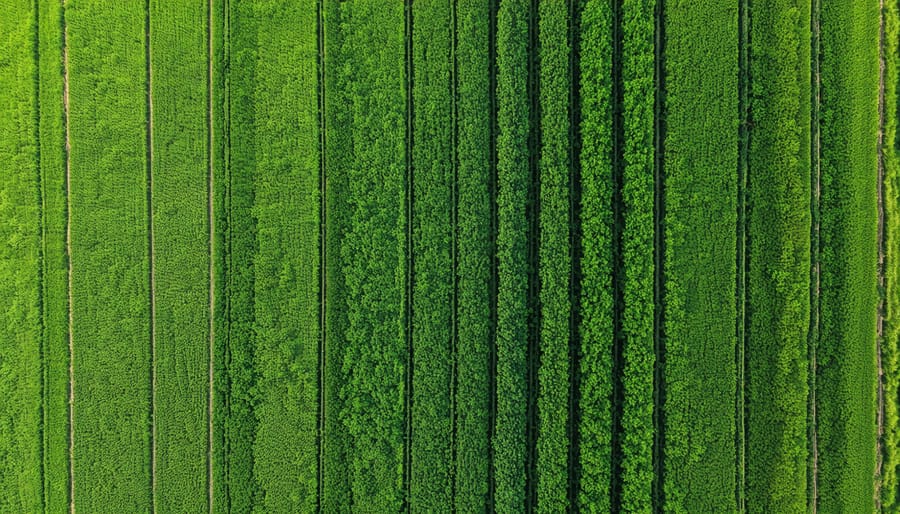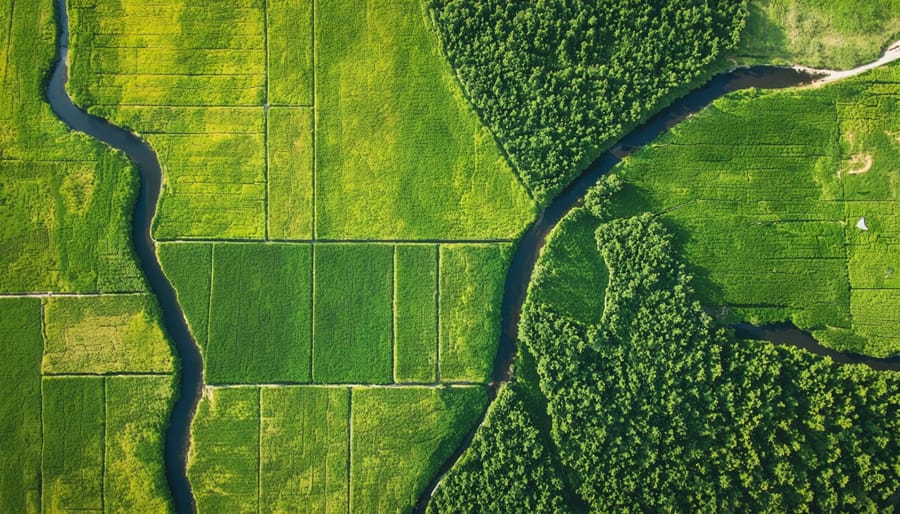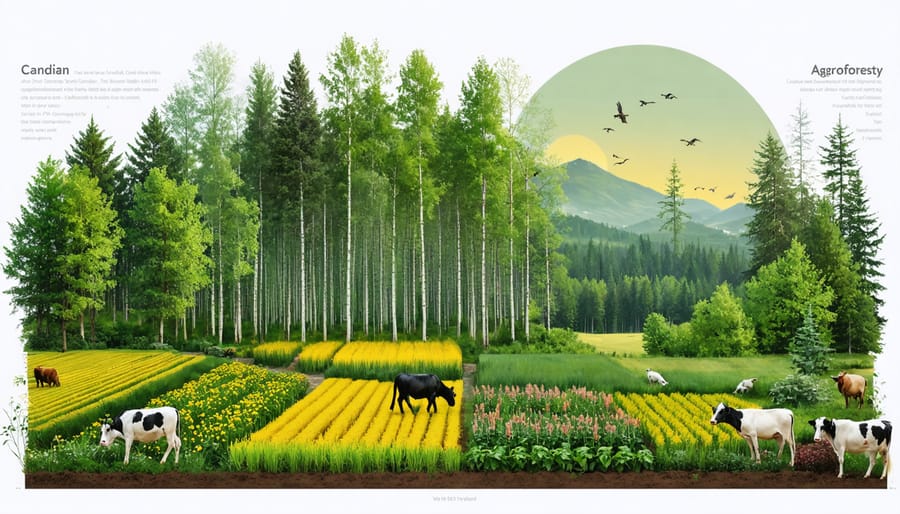Agroforestry transforms traditional farming landscapes into resilient, multi-layered ecosystems where trees, crops, and livestock work together in harmony. On Alberta’s prairie landscapes, this integrated approach combines deliberately planted trees and shrubs with conventional agricultural operations, creating sustainable food production systems that mirror natural forest environments. For Canadian farmers facing climate uncertainties and seeking income diversification, agroforestry offers a practical solution that enhances soil health, provides windbreaks, and generates multiple revenue streams throughout the year.
As third-generation Alberta farmer Mike Thompson demonstrates on his 800-hectare operation near Red Deer, modern agroforestry systems can include shelterbelts protecting grain fields, silvopasture areas where cattle graze beneath hybrid poplar stands, and fruit-bearing understory crops that thrive in partial shade. This intentional integration of woody perennials with annual crops and livestock represents more than just a farming method – it’s a sophisticated land management strategy that builds environmental resilience while supporting farm viability for future generations.
What Makes Agroforestry Different from Traditional Farming
The Three Essential Components
At the heart of every agroforestry system are three fundamental components that work together to create a sustainable and productive landscape. Trees form the backbone of these systems, providing long-term stability through their deep root systems and multiple benefits like shade, windbreaks, and soil enrichment. In Alberta, popular tree choices include white spruce and trembling aspen, which are well-adapted to our climate.
The agricultural crop component can include everything from wheat and canola to vegetables and herbs, depending on your specific goals and growing conditions. These crops benefit from the modified microclimate created by the trees while contributing to short-term income generation.
The livestock element, when present, adds another layer of integration. Cattle, sheep, or poultry can graze between trees, helping with weed control and adding natural fertilizer to the soil. Many Alberta farmers have found success rotating cattle through their silvopasture systems, particularly during our hot summer months when animals benefit from tree shade.
These three components don’t always need to be present simultaneously – some successful agroforestry systems combine just trees with crops or trees with livestock. The key is ensuring that whatever combination you choose works harmoniously within your specific farm context.
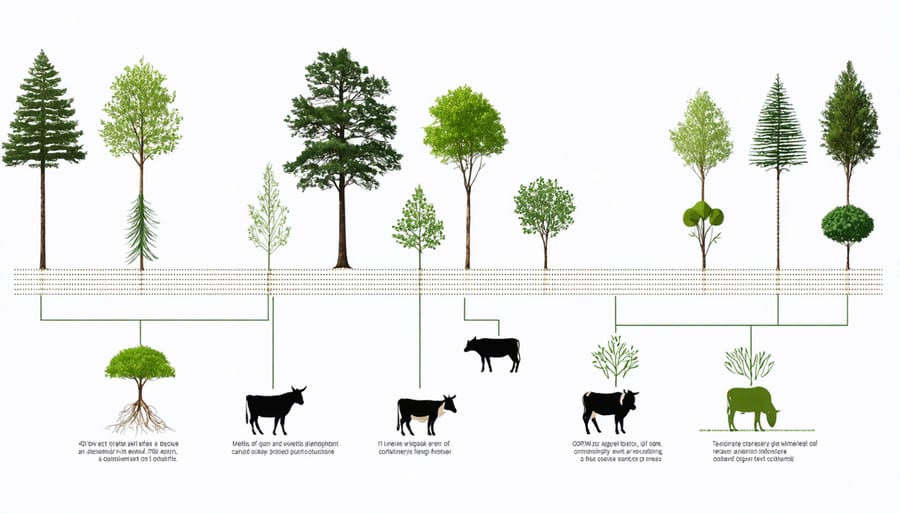
Benefits Beyond the Field
Agroforestry offers substantial rewards for Canadian farmers, extending well beyond traditional agricultural benefits. By building climate-resilient farms, producers can better withstand extreme weather events while creating additional income streams through diverse products like nuts, fruits, and timber.
The integration of trees and shrubs helps to improve soil health by reducing erosion and increasing organic matter content. This natural approach to land management also provides essential habitat for beneficial insects and wildlife, supporting local biodiversity and natural pest control.
For Alberta farmers, agroforestry systems can reduce input costs by naturally managing water resources and decreasing the need for synthetic fertilizers. The varied harvest times of different crops help stabilize farm income throughout the year, while shelterbelts protect valuable topsoil and livestock from harsh prairie winds. Many producers also report increased property values and opportunities for agritourism, creating additional revenue streams for their operations.
Alberta’s Agroforestry Success Stories
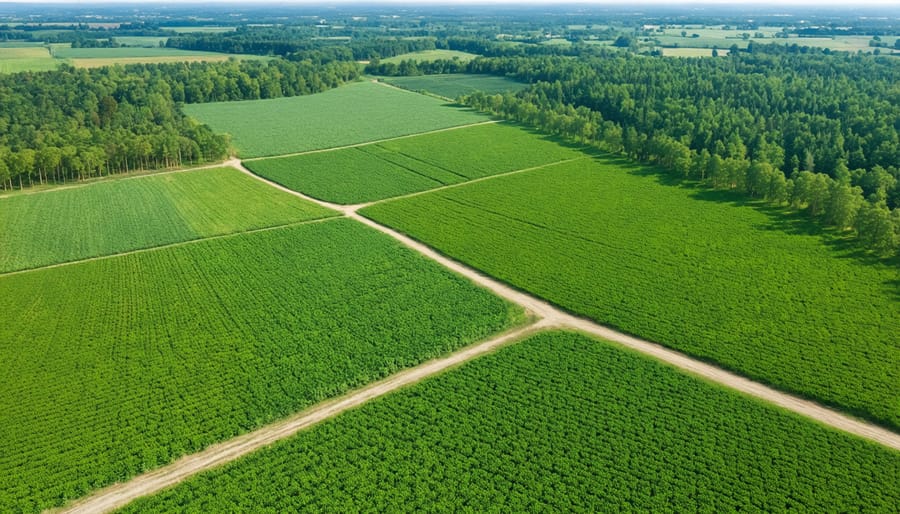
Case Study: The Smith Family Farm
Located just outside of Leduc, Alberta, the Smith Family Farm’s transformation from a traditional grain operation to a thriving agroforestry system showcases how farmers can boost farm profits through ecosystem services. In 2015, John and Sarah Smith made the bold decision to integrate trees and shrubs into their 300-hectare property, creating windbreaks and silvopasture systems.
The Smiths planted rows of hybrid poplars and white spruce along field boundaries, establishing natural windbreaks that protect their crops from harsh prairie winds. Between these rows, they maintain strips of cropland for wheat and canola production. In previously underutilized areas, they introduced saskatoon berries and chokecherries, creating additional revenue streams through U-pick operations and value-added products.
The results have been remarkable. Within five years, the Smiths reported a 15% reduction in irrigation needs due to improved moisture retention, and crop yields increased by 20% in areas protected by windbreaks. The berry enterprise now contributes approximately 25% of their annual farm income.
Perhaps most significantly, the diverse landscape has attracted beneficial insects and birds, naturally controlling pest populations and reducing pesticide costs by 30%. The Smith family’s success has inspired neighbouring farms to explore agroforestry practices, creating a growing community of innovative agricultural producers in central Alberta.
Expert Interview: Local Extension Officer
Sarah Thompson, a Regional Extension Officer with Alberta Agriculture and Forestry, brings over 15 years of experience helping local farmers integrate trees into their agricultural systems. “Agroforestry isn’t just about planting trees,” she explains. “It’s about creating sustainable farming systems that work with our unique Alberta climate and conditions.”
Thompson emphasizes that successful agroforestry in Alberta requires careful planning and species selection. “We’ve seen excellent results with shelterbelts using white spruce and caragana, which provide good wind protection for crops and livestock while supporting beneficial insects and birds.”
Drawing from her field experience, Thompson shares that many Alberta farmers start small, typically with windbreaks or silvopasture systems. “One of our most successful cases is a farm near Red Deer that integrated rows of hybrid poplars into their cattle pasture. Within five years, they noticed improved cattle welfare and increased forage production.”
She advises new adopters to connect with local agricultural offices and experienced agroforesters. “The community here is incredibly supportive. We offer free consultations and can connect farmers with mentors who’ve successfully implemented these systems. The key is starting with clear goals and being patient as the system establishes itself.”
For those interested in getting started, Thompson recommends attending local workshops and field days: “Seeing these systems in action and talking with other farmers is invaluable for understanding how agroforestry can work on your land.”
Practical Steps to Start Your Agroforestry Journey
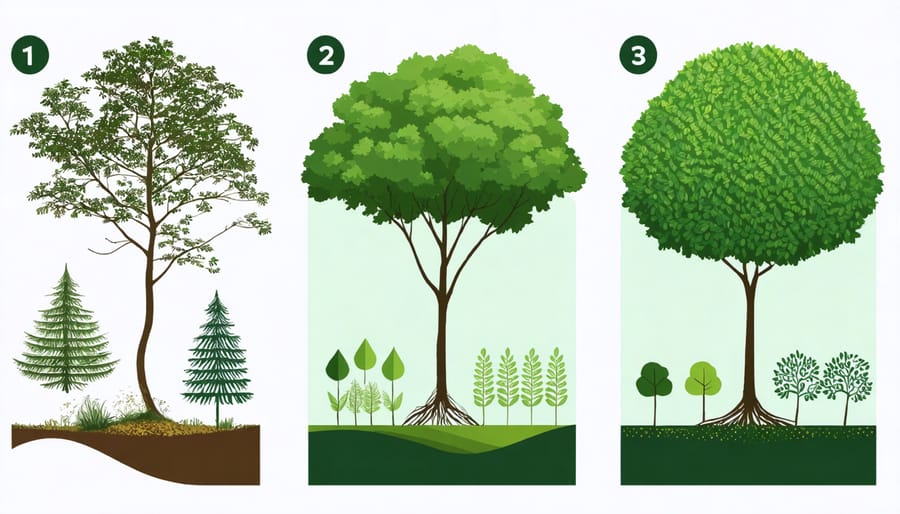
First Year Planning Guide
Starting an agroforestry system requires careful planning and preparation. Before diving in, assess your land’s characteristics, including soil type, drainage patterns, and existing vegetation. Consider consulting with local agricultural extension services or experienced agroforesters who understand Alberta’s unique climate conditions.
Begin by developing a detailed site plan. Map out areas for different components, considering factors like wind direction, sun exposure, and water accessibility. While understanding the costs and challenges of agroforestry is crucial, focus initially on selecting tree species that align with your goals and local climate.
Create a timeline for implementation, starting with soil preparation and establishing windbreaks if needed. Consider planting fast-growing nurse trees to provide initial protection for more valuable, slower-growing species. Plan for irrigation systems and ensure access routes for maintenance and harvest.
Establish a monitoring system to track growth patterns, soil health, and biodiversity changes. Connect with local farming networks and agricultural societies for support and knowledge sharing. Many successful Alberta agroforesters recommend starting small, perhaps with a 1-2 hectare pilot area, and scaling up based on learning experiences.
Remember to secure necessary permits and understand local regulations regarding tree planting and land use changes. Document everything – from initial soil tests to planting dates – as this information will be invaluable for future reference and system optimization.
Local Resources and Support
Alberta farmers interested in implementing agroforestry practices have access to numerous local resources and support systems. The Agroforestry and Woodlot Extension Society (AWES) offers comprehensive guidance, including site assessments, planning assistance, and educational workshops throughout the province. Their expertise helps farmers develop customized agroforestry plans suited to their specific land conditions and goals.
Agriculture and Agri-Food Canada provides funding through various programs, including the Agricultural Clean Technology Program and the Canadian Agricultural Partnership, which can help offset initial implementation costs. These programs often cover up to 50% of eligible expenses for qualifying projects.
The University of Alberta’s Department of Renewable Resources conducts ongoing research and offers extension services to farmers. Their demonstration sites across the province showcase successful agroforestry systems and provide hands-on learning opportunities.
Local agricultural societies and farmer-led organizations frequently host networking events and field days where experienced practitioners share their knowledge. The Alberta Woodlot Extension Program connects farmers with certified forestry experts who can provide technical advice on tree species selection and management practices.
For hands-on support, Conservation Districts throughout Alberta offer practical assistance with project planning and can help farmers access appropriate seedling materials through their tree nursery programs. Many districts also provide specialized equipment for rent, making implementation more accessible and cost-effective for local farmers.
Agroforestry represents a powerful opportunity for Canadian farmers to enhance their land’s productivity while contributing to environmental sustainability. Throughout this exploration of agroforestry’s definition and applications, we’ve seen how this integrated approach combines traditional farming wisdom with modern agricultural innovation.
For Alberta farmers, the benefits are clear: improved soil health, increased biodiversity, additional revenue streams, and enhanced climate resilience. The success stories from local farmers who have implemented shelterbelts, silvopasture systems, and riparian buffers demonstrate that agroforestry is not just a theoretical concept but a practical solution for our agricultural challenges.
As our farming community faces increasing environmental and economic pressures, agroforestry offers a viable path forward. Whether you’re managing a small family farm or a large agricultural operation, there’s an agroforestry system that can work for your specific needs and conditions.
We encourage you to take the first step by assessing your land’s potential for agroforestry integration. Connect with local agricultural extension services, join farmer networks, and consider attending workshops to learn more. Remember, you’re not alone in this journey – there’s a growing community of Canadian farmers embracing these practices, sharing knowledge, and supporting each other.
By adopting agroforestry practices, you’re not just investing in your farm’s future; you’re contributing to a more sustainable and resilient agricultural landscape for generations to come.

